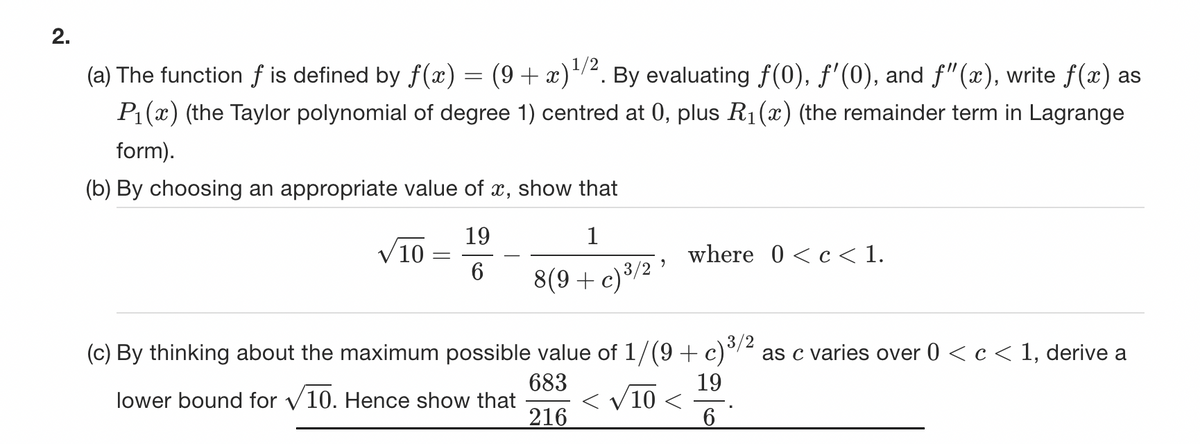2. (a) The function f is defined by f(x) = (9 + x)¹/². By evaluating ƒ(0), ƒ'(0), and ƒ"(x), write ƒ(x) as P₁(x) (the Taylor polynomial of degree 1) centred at 0, plus R₁(x) (the remainder term in Lagrange form). (b) By choosing an appropriate value of x, show that √10 19 6 1 8(9+ c) ³/2¹ where 0
2. (a) The function f is defined by f(x) = (9 + x)¹/². By evaluating ƒ(0), ƒ'(0), and ƒ"(x), write ƒ(x) as P₁(x) (the Taylor polynomial of degree 1) centred at 0, plus R₁(x) (the remainder term in Lagrange form). (b) By choosing an appropriate value of x, show that √10 19 6 1 8(9+ c) ³/2¹ where 0
Algebra & Trigonometry with Analytic Geometry
13th Edition
ISBN:9781133382119
Author:Swokowski
Publisher:Swokowski
Chapter1: Fundamental Concepts Of Algebra
Section1.3: Algebraic Expressions
Problem 20E
Related questions
Question
could you pleaae do all parts and could the answer be written out please , not typed up. Thank you

Transcribed Image Text:2.
(a) The function f is defined by f(x) = (9 + x) ¹/2. By evaluating ƒ(0), ƒ'(0), and ƒ"(x), write f(x) as
P₁(x) (the Taylor polynomial of degree 1) centred at 0, plus R₁(x) (the remainder term in Lagrange
form).
(b) By choosing an appropriate value of x, show that
19
1
6 8(9+ c) ³/2¹
√10
=
where 0<c<1.
(c) By thinking about the maximum possible value of 1/(9+ c)³/2 as c varies over 0 < c < 1, derive a
lower bound for V10. Hence show that < √10 <
683
19
216
6
Expert Solution
This question has been solved!
Explore an expertly crafted, step-by-step solution for a thorough understanding of key concepts.
Step by step
Solved in 3 steps

Recommended textbooks for you

Algebra & Trigonometry with Analytic Geometry
Algebra
ISBN:
9781133382119
Author:
Swokowski
Publisher:
Cengage

Algebra & Trigonometry with Analytic Geometry
Algebra
ISBN:
9781133382119
Author:
Swokowski
Publisher:
Cengage